Direct incorporation of paraffin wax as phase change material into mass concrete for temperature control:mechanical and thermal properties
Tao Luo,JuanJuan Ma,Fang Liu*,MingYi Zhang,ChaoWei Sun,YanJun Ji,XiaoSa Yuan
1.Shaanxi Key Laboratory of Safety and Durability of Concrete Structures,Xijing University,Xi'an,Shaanxi 710123,China
2. State Key Laboratory of Frozen Soil Engineering, Northwest Institute of Eco-Environment and Resources, Chinese Academy of Sciences,Lanzhou,Gansu 730000,China
ABSTRACT Taking advantage of heat absorbing and releasing capability of phase change material(PCM),Paraffin wax-based concrete was prepared to assess its automatic temperature control performance. The mechanical properties of PCM concrete with eight different Paraffin wax contents were tested by the cube compression test and four-point bending test. The more Paraffin wax incorporated, the greater loss of the compressive strength and bending strength. Based on the mechanical results, four contents of Paraffin wax were chosen for studying PCM concrete's thermal properties, including thermal conductivity, thermal diffusivity, specific heat capacity, thermal expansion coefficient and adiabatic temperature rise.When the Paraffin wax content increases from 10% to 20%, the thermal conductivity and the thermal diffusivity decrease from 7.31 kJ/(m·h·°C)to 7.10 kJ/(m·h·°C)and from 3.03×10-3 m2/h to 2.44×10-3 m2/h,respectively.Meanwhile the specific heat capacity and thermal expansion coefficient rise from 5.38×10-1 kJ/(kg·°C) to 5.76×10-1 kJ/(kg·°C) and from 9.63×10-6/°C to 14.02×10-6/°C, respectively.The adiabatic temperature rise is found to decrease with an increasing Paraffin wax content. Considering both the mechanical and thermal properties, 15% of Paraffin wax was elected for the mass concrete model test,and the model test results confirm the effect of Paraffin wax in automatic mass concrete temperature control.
Keywords: phase change material; Paraffin wax; temperature control; mechanical properties; thermal properties; mass concrete
1 Introduction
Mass concrete has been widely used in the construction of modern engineered structures, including mat foundations,dams,bridge piers and ports,etc..The large amount of heat produced during the hydration process by mass concrete, especially in concrete dams,cannot dissipate quickly, resulting in crack problems(Briffautet al., 2012; Ouyanget al., 2019; Zhouet al.,2019). Temperature control of mass concrete is necessary to prevent damage and meet project specifications.Commonly used temperature control methods for mass concrete include low-heat materials(Yanget al.,2007),precooling (Guoet al., 2017), post-cooling (Jinet al.,2001; Xie and Chen, 2005; Tzivanidiset al., 2012;Yanget al., 2012; Zhuet al., 2014; Liuet al., 2015;Chenget al., 2016), surface insulation (Ünalet al.,2007) and low-thermal-expansion aggregates (Chen and Won, 2007). While the above mentioned methods are effective in reducing the maximum temperature during the hydration process, they couldn't completely prevent temperature cracks from occurring in mass concrete. Meanwhile, these methods require complex construction and high engineering costs,and they cannot automatically and effectively regulate the temperature of mass concrete in the long term.There is an urgent need to develop more economical and effective means for temperature control in mass concrete.
Phase Change Material (PCM) can absorb and/or release heat during phase change at a nearly constant temperature. Taking advantages of PCM, many researchers use it as an admixture to enhance concrete's thermal properties. For example, impregnating PCM into concrete can increase its heat storage capacity to achieve energy savings in buildings. There are three different ways of applying PCM in buildings for energy saving (Pasupathyet al., 2008a), including walls(Peippoet al., 1991; Cabezaet al., 2007; Chenet al.,2008; Chenet al., 2018; Farahet al., 2018; Xieet al.,2018), other building components (Naganoet al.,2006; Pasupathyet al., 2008b; Entropet al., 2011)and separate heat or cold storages (Esen and Ayhan,1996; Esenet al., 1998; Zhuet al., 2009). Farnamet al. incorporated PCM into concrete pavement for ice and snow melting (Farnamet al., 2017). Many researchers have confirmed the effectiveness of PCM incorporated into concrete on peak temperature reduction during the hydration process (Hungeret al.,2009; Kimet al., 2015; Drissiet al., 2019). The temperature rise in cement paste can also be delayed for a longer time using PCM(Šavija and Schlangen,2016).
Based on the thermal effects of PCM incorporation into concrete,several studies suggested that incorpation of PCM into concrete can potentially control and mitigate the thermal stress and cracking of concrete structures during the cement hydration process(Hungeret al., 2009; Fernandeset al., 2014; Šavija and Schlangen, 2016; Aroraet al., 2017). However,studies have also shown that PCM incorporation could significantly reduce the compressive strength of concrete (Cabezaet al., 2007; Eddhahak-Ouniet al.,2014; Cunhaet al., 2015; Weiet al., 2017). For concrete structures, the amount of PCM incorporation should be decided by achieving a balance between the thermal and mechanical effects.
There are usually two methods for PCM incorporation into concrete: direct and indirect. The direct method is adding the PCM directly to concrete during production, which was mainly used in earlier studies(Haweset al., 1989; Feldmanet al., 1991; Soaresetal.,2013;Liet al.,2014;Navarroet al.,2016).The potential risk of this method includes PCM interactaction with the surrounding matrix and hence alteration of its properties and leakage problems. The indirect method is incorporation of encapsulated PCM or lightweight aggregates containing PCM in concrete, which has become popular in recent studies (D'Alessandroet al.,2018; Wanget al., 2018; Berardi and Gallardo, 2019;Hassanet al., 2019; Quet al., 2020). Considering the large amount of concrete consumed in mass concrete structures, construction process and engineering cost,the direct method is adopted in this study for evaluating its feasibility in temperature control of mass concrete.
This study investigates the effect of the content of Paraffin wax on the mechanical and thermal properties of concrete and evaluates the temperature control effect of its incorporation into mass concrete. Sectoin 2 introduces the materials and experimental scheme design. Section 3 describes the compression and fourpoint bending testing results. And section 4 analyzes the thermal test results, including thermal conductivity,thermal diffusivity, specific heat capacity, thermal expansion coefficient and adiabatic temperature rise.Section 5 compares the temperature rise of PCM concrete with that of ordinary concrete during cement hydration process.Finally,section 6 draws the main conclusions.
2 Materials and methods
2.1 Materials
Ordinary Portland cement PO42.5 was used.Table 1 and Table 2 list its physical properties and chemical compositions, respectively. A natural river sand with an apparent density of 2,500 kg/m3and a fineness module of 2.53 was used as fine aggregates,and a crushed stone with continuous grading between 5 mm and 20 mm and an apparent density of 2,860 kg/m3was used as coarse aggregates. Fly ash is a common additive used to improve the strength, durability and save cost in concrete. Table 3 shows the physical properties of the fly ash applied in this study.Superplasticizers are another common additive to enhance the strength of concrete and the one produced by Shaanxi Qinfen Building Materials Co., Ltd., was adopted in this study. The Paraffin wax (China National Petroleum Corporation) was used as the PCM, and Table 4 lists its physical properties.Table 5 presents the reference concrete mix proportion used in this study, and the Paraffin wax was designed to replace an equal volume of sand at different contents.

Table 1 The physical properties of Portland cement

Table 2 The chemical compositions of Portland cement

Table 3 The physical properties of fly ash

Table 4 The physical properties of Paraffin wax

Table 5 The reference concrete mix proportion
2.2 Sample preparation
The procedure for preparing Paraffin wax incorporated concrete is:
1) Preparing all the materials according to the mix proportion in Table 5;
2) Cleaning the mixer, putting in gravel, sand, cement, fly ash, Paraffin wax and superplasticizer in turn,then dry mixing for 2 minutes;
3)Adding water and mixing slowly for 2 minutes;
4)Pouring the mixed fresh concrete into the mold.
2.3 Testing methods
2.3.1 Mechanical properties testing
The compressive strength and four-point bending strength of PCM concrete were considered in this study. Samples of 100 mm in width ×100 mm in height ×100 mm in length were used for compressive strength test, and those of 150 mm in width ×150 mm in height×550 mm in length were used for Four-point bending test. After preparation, all the samples were cured for 28 days in standard curing room with a temperature of 20±2 °C and a relative humidity of 95%.A MTS universal testing machine (Figure 1) was used for both the compression test (Figure 2) and fourpoint bending test(Figure 3).
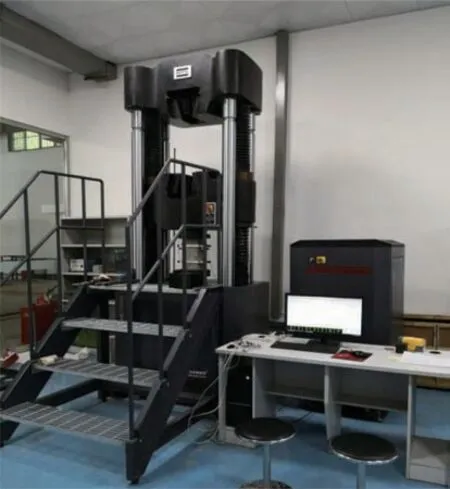
Figure 1 A MTS universal testing machine
2.3.2 Thermal properties testing
The thermal properties, including thermal conductivity, thermal diffusivity, specific heat capacity, thermal expansion coefficient and adiabatic temperature rise, were obtained by an integrated thermal physical analyzer(Figure 4).Figure 5 illustrates the testing setups for various thermal properties. Cylindrical samples with dimensions of 200 mm in radius and 400 mm in height were used for analyzing the thermal conductivity, thermal diffusivity and specific heat capacity.Slightly taller cylindrical samples with the same radius and a height of 500 mm was used for analyzing the thermal expansion coefficient. Much larger cylindrical samples of 400 mm in both radius and height were used for evaluating the adiabatic temperature rise.
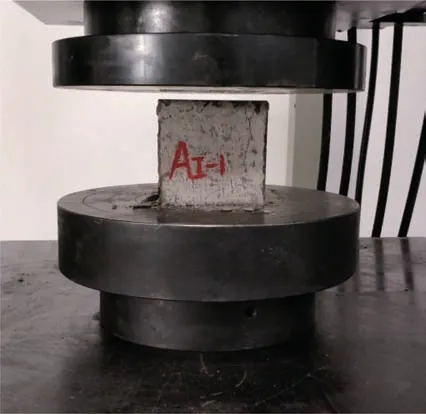
Figure 2 The compressive strength test
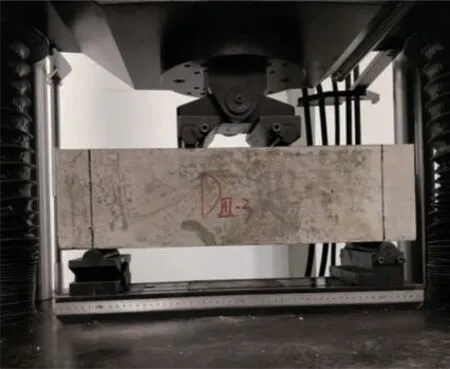
Figure 3 The four-point bending strength test
2.3.3 Model test of concrete temperature control
The specimens for temperature-control model tests are 600-mm cubes. The molds were made of wood with 5-cm thick expanded polystyrene (EPS) board used as the inner wall to prevent heat loss (Figure 6).The interior temperatures at different positions (Figure 7)were monitored by twenty thermometers with a precision of 0.1°C and a measurement range of 0-80°C.
3 Results and analyses of compression and four-point bending tests
Seven different contents of Paraffin wax, including 10%, 20%, 30%, 40%, 50%, 60% and 70% of the sand volume, were considered for the compression and four-point bending tests, respectively. Table 6 presents the mix proportion of PCM concrete tested in this study.

Figure 4 An integrated thermal physical analyzer
3.1 Compressive strength
The compressive strength test results are illustrated in Figure 8. The incorporation of Paraffin wax inevitably leads to a decrease in the compressive strength.For instance, at a Paraffin wax content of 10%, the strength loss ratio is 15%; at a Paraffin wax content greater than 50%, the strength loss ratio grows to more than 50%. Overall, the compressive strength loss ratio is inversely proportional to the content of incorporated Paraffin wax.
3.2 The four-point bending strength
The strength results from four-point bending tests are shown in Figure 9. Similar to the compressive strength,the addition of Paraffin wax into concrete also leads to a significant reduction in its bending strength.When the content of Paraffin wax incorporation increases from 10% to 50%, the bending strength loss ratio increases from 14%to 25%.Once the Paraffin wax incorporation is more than 50%, the bending strength drops below 3 MPa, or by more than 30%. It can be concluded that the increase of Paraffin wax incorporation reduces the maximum load-bearing capacity. The bending strength is controlled by the bonding strength of the interface between the coarse aggregate and its surrounding materials and the strength of the cement mortar. With an increasing river sand replacement ratio, the strength of the cement mortar decreases, indirectly reducing the interface bonding strength and,hence,the bending strength of the concrete.
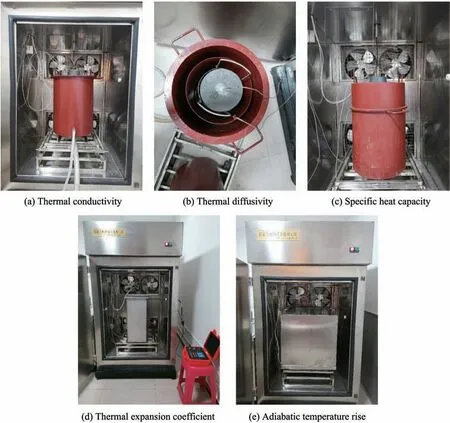
Figure 5 Testing setups for various thermal properties
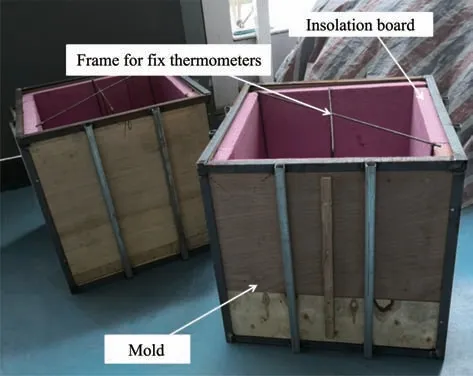
Figure 6 The molds for model test
4 Analyses of thermal properties
Considering that the concrete needs to work as structural members and based on the results of the compressive and four-point bending strengths,20% of Paraffin wax incorporation was deemed as the largest content for mass concrete. As a result, a total of three Paraffin wax contents were considered for thermal tests, and Table 7 lists the mix proportions. Note that the concrete without Paraffin wax serves as a reference.
4.1 Thermal conductivity
Figure 10 depicts how the thermal conductivity of PCM concrete varies with Paraffin wax content.Oveall, the impact of Paraffin wax on the thermal conductivity of the PCM concrete is small. As the Paraffin wax content increases from 10% to 20%, the thermal conductivity decreases from 7.31 kJ/(m·h·°C)to 7.10 kJ/(m·h·°C), or by 2.87%. Incorporating 20%Paraffin wax content results in 0.77 kJ/(m·h·°C)reduction, or about 10%, in the thermal conductivity when compared with that of the reference concrete.

Table 6 The mix proportion of concrete with various PCM contents
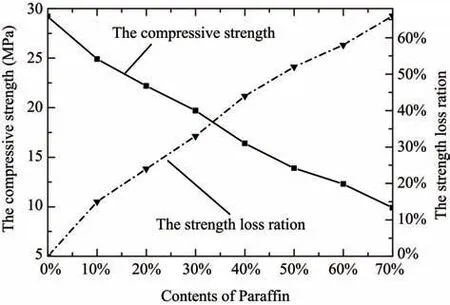
Figure 8 The compressive strength and strength loss ratio versus Paraffin wax content
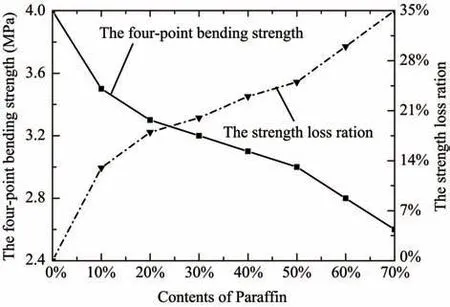
Figure 9 The four-point bending strength and strength loss ratio versus Paraffin wax content
4.2 Thermal diffusivity
Figure 11 illustrates how the thermal diffusivity changes with Paraffin wax content Similar to thermal conductivity, the thermal diffusivity of Paraffin wax incorporated PCM concrete decreases when compared with that of the reference concrete. When the Paraffin wax content increases from 10% to 20%, the thermal diffusivity falls from 3.03×10-3m2/h to 2.44×10-3m2/h,or by about 19%. With respect to the reference concrete, the thermal diffusivity of PCM concrete with 20% Paraffin wax reduces by 1.33×10-3m2/h, or about 35%. Therefore, the effect of Paraffin wax incorporation on the thermal diffusivity is more prominent than on the thermal conductivity.
4.3 Specific heat capacity
Figure 12 demonstrates the variation of specific heat capacity with different contents of Paraffin wax incorporated PCM concrete. Contrary to the thermal conductivity and thermal diffusivity, the specific heat capacity of Paraffin wax incorporated PCM concrete is larger than the reference concrete.As the content of the Paraffin wax increases from 10% to 20%, the specific heat capacity rises from 5.38×10-1kJ/(kg·°C) to 5.76×10-1kJ/(kg·°C),or 7%.
4.4 Thermal expansion coefficient
Figure 13 reveals the thermal expansion coefficient of the PCM concrete at various Paraffin wax contents.Like the specific heat capacity, the thermal expansion coefficient of Paraffin wax incorporated PCM concrete is also larger than that of the reference concrete.As the Paraffin wax content increases from 10% to 20%, the thermal expansion coefficient increases rapidly from 9.63×10-6/°C to 14.02×10-6/°C,or by about 46%.Compared to the reference concrete, the thermal expansion coefficient of the PCM concrete with 20% of Paraffin wax rises by 4.57×10-6/°C,i.e., about 48%. However,the thermal expansion coefficient of the PCM concrete with 10% of Paraffin wax only increases by about 2%compared to the reference concrete.

Table 7 The mix proportions of PCM concrete for thermal tests
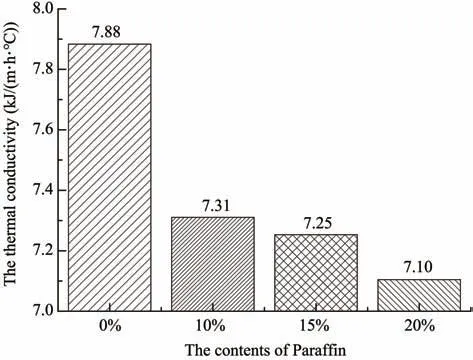
Figure 10 The thermal conductivity versus Paraffin wax content

Figure 11 The thermal diffusivity versus Paraffin wax content
4.5 Adiabatic temperature rise
The adiabatic temperature rise in the PCM concrete of different Paraffin wax contents is shown in Figure 14. With the increasing in concrete age, the adiabatic temperature rise monotonically grows.Compared with the reference concrete, however, the adiabatic temperature rise of Paraffin wax incorporated PCM concrete is smaller.As the Paraffin wax content increases, the adiabatic temperature rise becomes smaller. By the age of 28 days, the adiabatic temperature rise of PCM concrete with 20% Paraffin wax is 26.7 °C,which is 11.2 °C lower than that of the reference concrete.
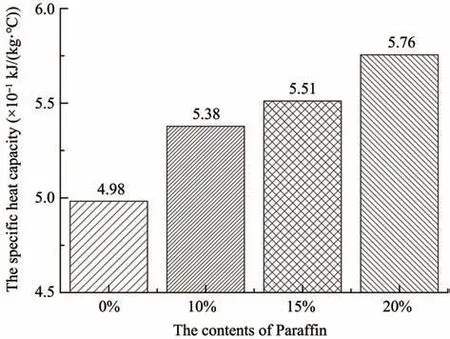
Figure 12 The specific heat capacity versus Paraffin wax content
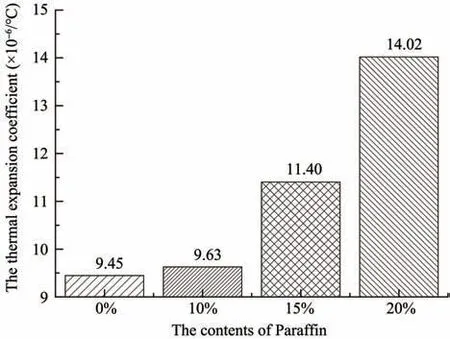
Figure 13 The thermal expansion coefficient versus Paraffin wax content
5 Model test of mass concrete temperature control
Considering both the mechanical and thermal properties, 15% was elected as the desired Paraffin wax content for temperature control model test. Figure 15 shows the two model test: one with PCM concrete and the other of reference concrete.
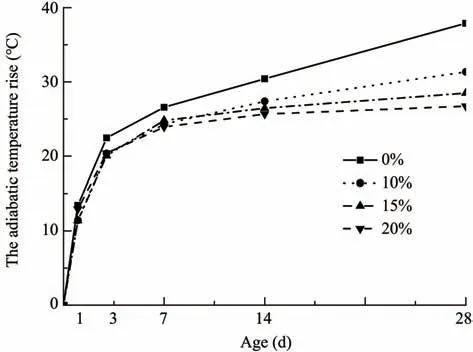
Figure 14 The adiabatic temperature rise
The thermometer labels in the two models are illustrated in Figure 16.The thermometers in PCM concrete and ordinary concrete are numbered from 1 to 20 and from 21 to 40, respectively. Two sections are chosen within each model for temperature distribution analysis.
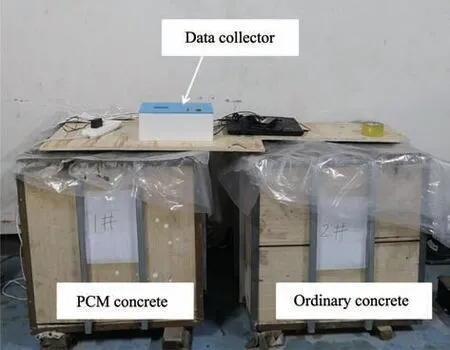
Figure 15 The temperature control model tests of mass PCM concrete and the reference concrete
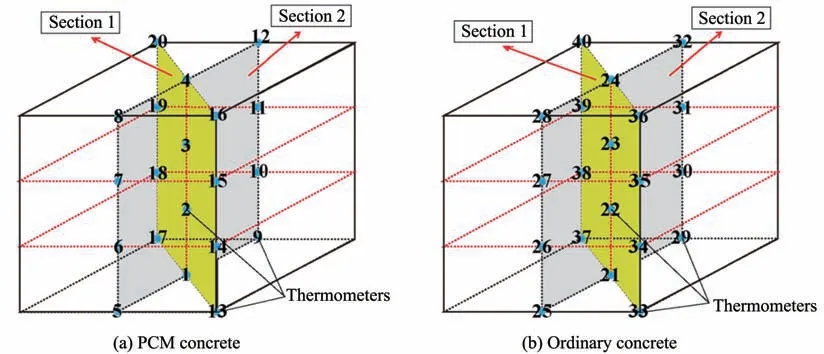
Figure 16 The thermometer labels in two models
5.1 Temperature change with time
The variation of temperature with time during the hydration stage for thermometers 2, 3, 22, and 23, is illustrated in Figure 17 to compare the differences between PCM concrete and ordinary concrete. The temperature in the center of mass concrete increases rapidly after pouring. After curing of 19 h, the temperature of the ordinary concrete reaches its peak value of 48.7°C,while the peak value of PCM concrete,namely 46.8 °C, arrives 16 h after the ordinary concrete.After the peak, the temperature of ordinary concrete decreases faster than PCM concrete.About 96 h after pouring,the temperature in the center of ordinary concrete is about 4 °C lower than in the center of PCM concrete. This comparison demonstrates that the Paraffin wax can not only reduce the rate of temperature rise and drop,but also the peak of temperature rise.
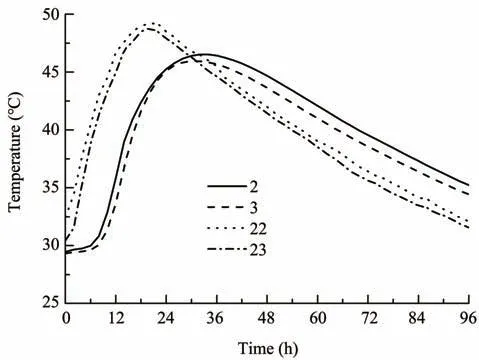
Figure 17 Variation of temperature with time at selected locations
5.2 Temperature distribution within the mass concrete model
The temperature distributions in sections 1 and 2(as shown in Figure 16) for PCM concrete and ordinary concrete are shown in Figures 18 and 19, respectively.The initial temperatures of PCM concrete and ordinary concrete range from about 29°C to 31°C,and the temperatures are uniformly distributed for both models.After 24 h,the temperature increases rapidly due to the hydration of cement, with the temperature in the center of each model higher than the surrounding area.Additionally,the temperature on the top surface is lower than that on the bottom, which is consistent with the boundary conditions. Overall, the temperature distribution in PCM concrete is more uniform than in the ordinary concrete.Due to the lower thermal diffusivity,the temperature of the PCM concrete changes slower than the ordinary concrete. The largest temperature difference between the center and the surrounding of the PCM concrete is about 4 °C, while the largest temperature difference of the ordinary concrete is about 6 °C. This observation means that the PCM concrete has lower risk of temperature-induced cracks during the hydration stage.
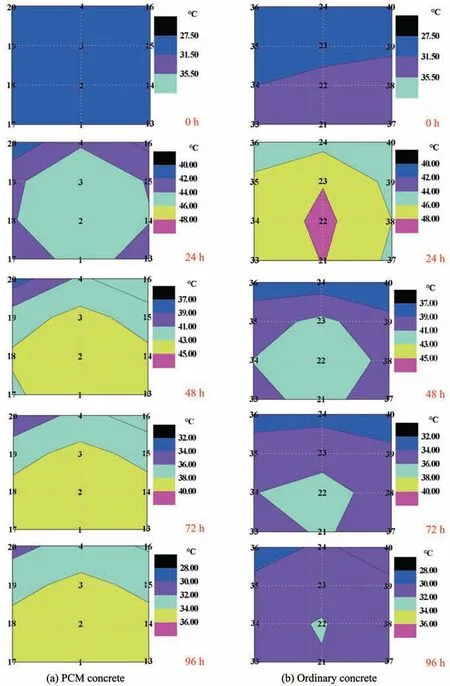
Figure 18 The temperature distribution in section 1

Figure 19 The temperature distribution in section 2
6 Conclusions
Considering the construction process and engineering cost, the direct way of incorporating Paraffin wax into concrete is adopted for preparing PCM concrete. The mechanical properties of PCM concrete with eight different Paraffin wax contents are tested by the compression test and four-point bending test.Based on the mechanical property results, PCM concrete with four Paraffin wax contents are chosen for studying its thermal properties,including thermal conductivity, thermal diffusivity, specific heat capacity,thermal expansion coefficient and adiabatic temperature rise. By combining the mechanical and thermal results,PCM concrete with 15% Paraffin wax is elected for mass concrete model test.The effect of Paraffin wax in automatic temperature control of concrete is confirmed by the results of the model tests. The main conclusions can be drawn as follows.
(1)The incorporation of Paraffin wax will inevitably lead to a decrease in the concrete compressive strength and bending strength. The more Paraffin wax is incorporated, the greater loss of the compressive strength and bending strength. When the content of Paraffin wax incorporation is greater than 50%, the compressive strength loss ratio is more than 50%, and the bending strength loss ratio is more than 30%.
(2)The thermal conductivity and thermal diffusivity of the PCM concrete are smaller than the concrete without Paraffin wax. As the content of Paraffin wax increases from 10% to 20%, the thermal conductivity decreases from 7.31 kJ/(m·h·°C) to 7.10 kJ/(m·h·°C),or by less than 3%, while the thermal diffusivity drops from 3.03×10-3m2/h to 2.44×10-3m2/h, or about 19%. The incorporation of Paraffin wax has more impact on the thermal diffusivity than on the thermal conductivity.
(3) Contrary to the thermal conductivity and the thermal diffusivity, the specific heat capacity and thermal expansion coefficient of Paraffin wax incorporated PCM concrete are larger than the concrete without Paraffin wax.As the Paraffin wax content increases from 10% to 20%, the specific heat capacity and the thermal expansion of PCM concrete rises from 5.38×10-1kJ/(kg·°C) to 5.76×10-1kJ/(kg·°C), or by 7%, and from 9.63×10-6/°C to 14.02×10-6/°C, or by 46%,respectively.
(4) The adiabatic temperature rise increases with the age of concrete. The adiabatic temperature rise of Paraffin wax incorporated PCM concrete is smaller than the concrete without Paraffin wax, and a larger Paraffin wax content leads to a smaller adiabatic temperature rise.
(5) The effectivness of Paraffin wax on temperature control in mass concrete is confirmed by the mass concrete model test. It is demonsteated that the Paraffin wax can not only reduce the rate of temperature rise and drop but also the peak temperature rise.Overall, the temperature distribution in PCM concrete is more uniform than in the ordinary concrete. And due to the lower thermal diffusivity, the temperature of the PCM concrete changes slower than the ordinary concrete. The largest temperature difference between the center and the surrounding of the PCM concrete is about 4 °C, while the largest temperature difference of the ordinary concrete is about 6 °C. In other words, the PCM concrete has a lower risk of temperature-induced cracks during the hydration stage.
Acknowledgments:
This work is jointly supported by the National Natural Science Foundation of China (Grant Nos. 51909223,51902270), the National Science Fund for Distinguished Young Scholars (Grant No. 41825015), the Natural Science Basic Research Program of Shaanxi(Grant No. 2019JQ-921), the Special research project of the Education Department of Shaanxi Provincial Government (Grant No.19JK0913) and the Special Fund for the Launch of Scientific Research in Xijing University(Grant No.XJ18T02).
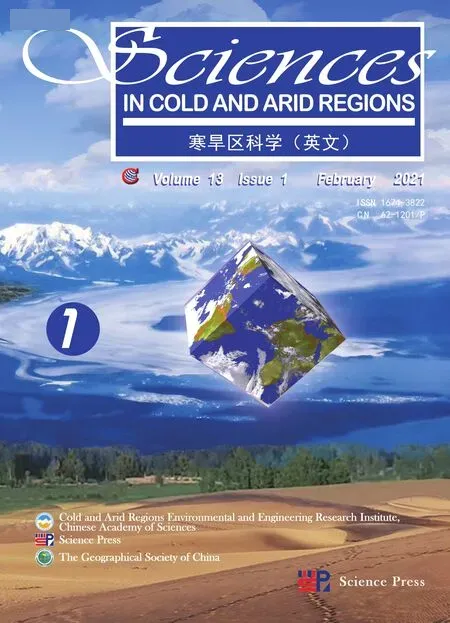 Sciences in Cold and Arid Regions2021年1期
Sciences in Cold and Arid Regions2021年1期
- Sciences in Cold and Arid Regions的其它文章
- Constitutive models and salt migration mechanisms of saline frozen soil and the-state-of-the-practice countermeasures in cold regions
- Simulated effect of soil freeze-thaw process on surface hydrologic and thermal fluxes in frozen ground region of the Northern Hemisphere
- Response of revegetation to climate change with meso-and micro-scale remote sensing in an arid desert of China
- The evapotranspiration and environmental controls of typical underlying surfaces on the Qinghai-Tibetan Plateau
- Evaluating effects of Dielectric Models on the surface soil moisture retrieval in the Qinghai-Tibet Plateau
